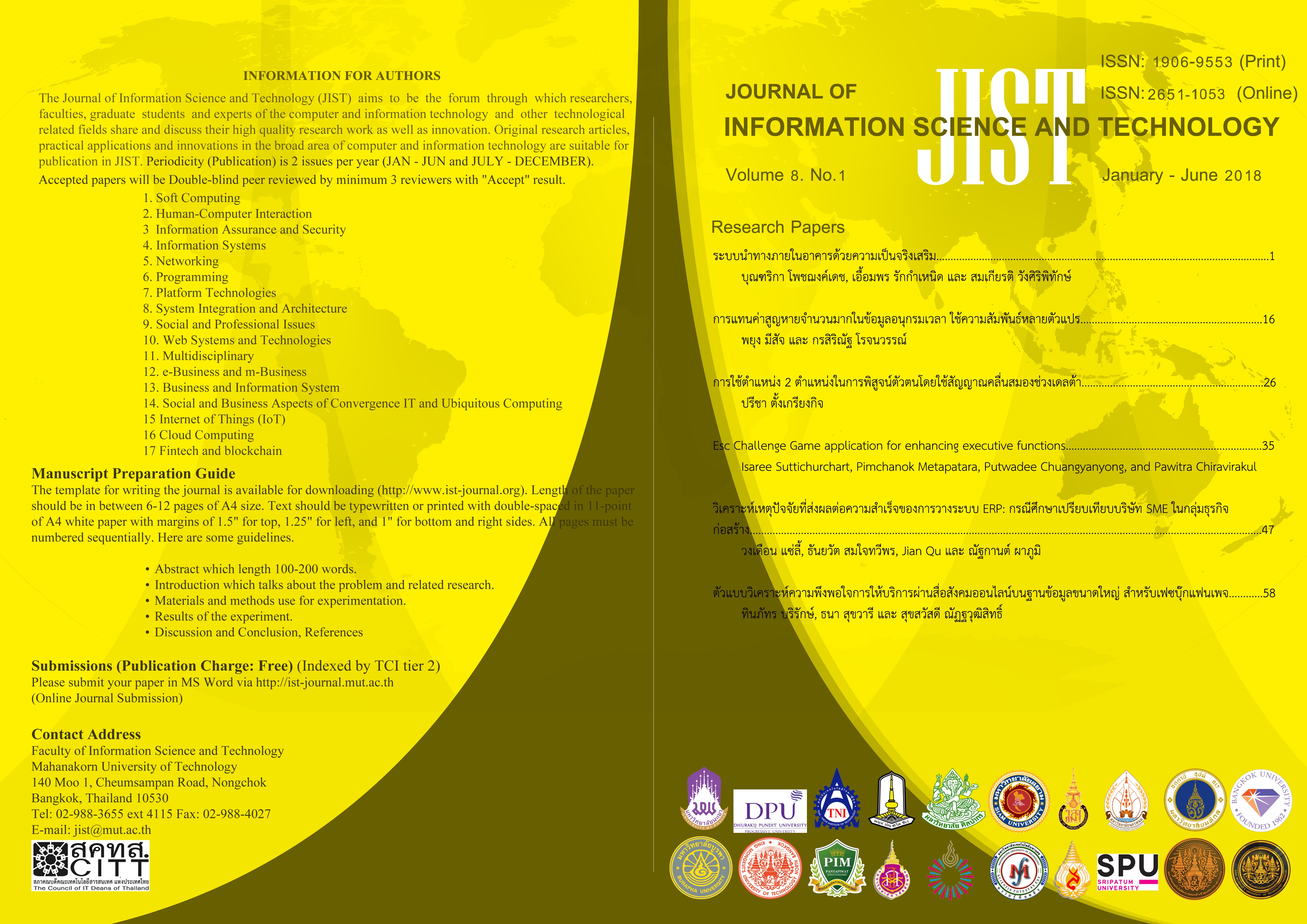วิเคราะห์เหตุปัจจัยที่ส่งผลต่อความสำเร็จของการวางระบบ ERP: กรณีศึกษาเปรียบเทียบบริษัท SME ในกลุ่มธุรกิจก่อสร้าง
Main Article Content
บทคัดย่อ
- งานวิจัยชิ้นนี้แสดงผลลัพธ์ในลักษณะของรายงานเพื่อนำเสนอผู้บริหารระดับสูง แสดงผลของการวิเคราะห์เชิงลึกถึงความเชื่อมโยงของเหตุปัจจัยที่ทำให้เกิดความสำเร็จหรือล้มเหลวของการวางระบบERP ในองค์กรในกลุ่มธุรกิจก่อสร้าง ผลการวิเคราะห์ดังกล่าวเป็นผลลัพธ์ของการวิจัยแบบกรณีศึกษาเชิงเปรียบเทียบ โดยมีกรณีศึกษาเป็นบริษัทที่ประสบผลสำเร็จและบริษัทที่ประสบปัญหาในการวางระบบ ERP โดยพิจารณาระยะเวลาของโครงการ งบประมาณ และความเสถียรของระบบ งานวิจัยได้ผสานแนวปฏิบัติดั้งเดิมของการวิเคราะห์ข้อมูลเชิงคุณภาพและเครื่องมือของทฤษฎี system thinking ผู้วิจัยขอสนับสนุนการวิจัยเชิงประยุกต์นี้เพื่อส่งเสริมความเข้าใจในองค์รวมของสถานการณ์ที่ต้องการวิเคราะห์
Article Details
This work is licensed under a Creative Commons Attribution-NonCommercial-NoDerivatives 4.0 International License.
I/we certify that I/we have participated sufficiently in the intellectual content, conception and design of this work or the analysis and interpretation of the data (when applicable), as well as the writing of the manuscript, to take public responsibility for it and have agreed to have my/our name listed as a contributor. I/we believe the manuscript represents valid work. Neither this manuscript nor one with substantially similar content under my/our authorship has been published or is being considered for publication elsewhere, except as described in the covering letter. I/we certify that all the data collected during the study is presented in this manuscript and no data from the study has been or will be published separately. I/we attest that, if requested by the editors, I/we will provide the data/information or will cooperate fully in obtaining and providing the data/information on which the manuscript is based, for examination by the editors or their assignees. Financial interests, direct or indirect, that exist or may be perceived to exist for individual contributors in connection with the content of this paper have been disclosed in the cover letter. Sources of outside support of the project are named in the cover letter.
I/We hereby transfer(s), assign(s), or otherwise convey(s) all copyright ownership, including any and all rights incidental thereto, exclusively to the Journal, in the event that such work is published by the Journal. The Journal shall own the work, including 1) copyright; 2) the right to grant permission to republish the article in whole or in part, with or without fee; 3) the right to produce preprints or reprints and translate into languages other than English for sale or free distribution; and 4) the right to republish the work in a collection of articles in any other mechanical or electronic format.
We give the rights to the corresponding author to make necessary changes as per the request of the journal, do the rest of the correspondence on our behalf and he/she will act as the guarantor for the manuscript on our behalf.
All persons who have made substantial contributions to the work reported in the manuscript, but who are not contributors, are named in the Acknowledgment and have given me/us their written permission to be named. If I/we do not include an Acknowledgment that means I/we have not received substantial contributions from non-contributors and no contributor has been omitted.
เอกสารอ้างอิง
2. L. Shaul, and D. Tauber, “Critical success factors in enterprise resource planning systems: Review of the last decade”, ACM Comput. Surv. Vol. 45 (4), Article 55, 39 pages, 2013.
3. K. Al-Fawaz, Z. Al-Salti, and T. Eldabi, “Critical Success Factors in ERP Implementation: A Review”, European and Mediterranean Conference on Information Systems (EMCIS2008). May 25-26, 2008.
4. S. Finney, and M. Corbett, "ERP implementation: a compilation and analysis of critical success factors", Business Process Management Journal, Vol. 13 (3), pp. 329-347, 2007.
5. C. Suebsin, and N. Gerdsri, “Technology adoption: A case study of ERP implementation in one of healthcare organizations in Thailand,” PICMET 2010 Technology management for global economic growth, Phuket, 2010, pp. 1-8, 2010.
6. P. Wanchai, “Key Factors for Successful ERP Implementation: Case Studies from Private and Public Organizations in Thailand,” In: Piazolo F., Geist V., Brehm L., Schmidt R. (eds) Innovations in Enterprise Information Systems Management and Engineering. ERP Future 2016. Lecture Notes in Business Information Processing, Vol. 285, Springer, 2016.
7. J. L. Schiff, “11 common ERP mistakes and how to avoid them” CIO from IDG Communications, Inc. 2017. Available: https://www.cio.com/article/2397802/enterprise-resource-planning/article.html. [Accessed May, 2018].
8. J. Peppard, “A Tool for Balancing Your Company’s Digital Investments” Harvard Business Review, 2016. Available: https://hbr.org/2016/10/a-tool-for-balancing-your-companys-digital-investments. [Accessed May, 2018].
9. Panorama Consulting Solutions, “2018 ERP report”, 2018. [Accessed May, 2018].
10. J. E. Sousa, and J. P. Collado, “Towards the unification of critical success factors for ERP implementations” In: Proceedings of 10th Annual Conference Business Information Technology (BIT) Manchester, 2000.
11. K. M. Cyrus, D. Aloini, and S. Karimzadeh, “How to disable mortal loops of enterprise resource planning (ERP) implementation: a system dynamics analysis.” Systems 2018, Vol. 6(3), 2018.



